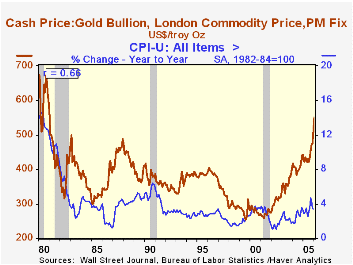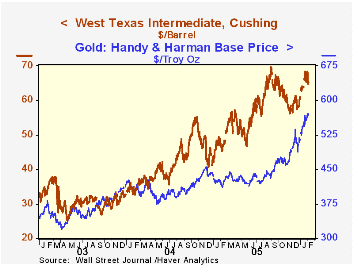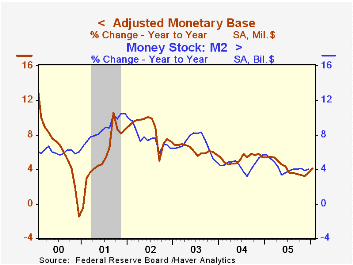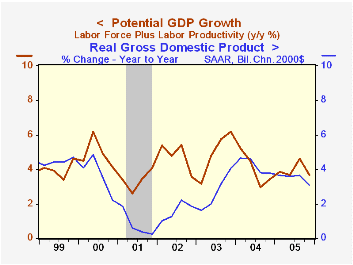 Global| Feb 06 2006
Global| Feb 06 2006Gold & Oil Prices Higher Still
by:Tom Moeller
|in:Economy in Brief
Summary
Friday's gold price of $569 per ounce underscored concerns that inflationary price pressures continue to build. Since 1980 there has been a 66% correlation between the level of gold prices and the y/y change in consumer prices. Gold [...]

Friday's gold price of $569 per ounce underscored concerns that inflationary price pressures continue to build. Since 1980 there has been a 66% correlation between the level of gold prices and the y/y change in consumer prices. Gold prices, certainly, have been higher. In 1980 they neared $700 per ounce. But gold prices reflect and do not cause higher prices. 
Higher oil prices fueled much of the real concern. On Friday, spot WTI crude stood at $65.38 per barrel. That was down slightly from earlier highs near $68 but prices nevertheless remained up 44% from the year ago level.
Conversely, U.S. economic pressures that might generate inflation have subsided recently. Monetary pressures certainly are down as a result of the Fed's efforts to raise interest rates. Growth in the monetary base and M2 both have decelerated to roughly 4%, a 50% deceleration from earlier rates of growth generated to combat deflation fears.
Real economic growth also has slowed. After surpassing the Congressional Budget Office's estimate of potential for just two years, U.S. GDP growth at 3.1% through 4Q05 is back down to potential. A separate calculation of the U.S. economy's potential, however, suggests that less pressure built up (see chart) when the economy was stronger.
Imported inflation? With economic growth perking up abroad the question might be asked. But during the last five years growth in the major seven OECD countries has averaged a sub par 2.2%, well below the 3.0% rates of growth during the late 1990s and the 4.0% growth rates during the late 1980s. Additionally, the real value of the U.S. dollar against its major trading partners recently has strengthed.
The Long-Run Benefits of Sustained Low Inflation from the Federal Reserve Bank of St. Louis can be found here.
Energy Prices and the Economy, a 2004 article from the Federal Reserve Bank of Dallas is available here.
| Weekly Prices | 01/31/06 | 12/27/05 | Y/Y | 2005 | 2004 | 2003 |
|---|---|---|---|---|---|---|
| Light Sweet Crude Oil, WTI (per bbl.) | $67.93 | $58.16 | 44.1% | $57.59 | $41.73 | $31.00 |
| Gold: Handy & Harmon (per Troy Oz.) | $568.75 | $507.40 | 35.1% | $447.13 | $411.72 | $367.78 |
Tom Moeller
AuthorMore in Author Profile »Prior to joining Haver Analytics in 2000, Mr. Moeller worked as the Economist at Chancellor Capital Management from 1985 to 1999. There, he developed comprehensive economic forecasts and interpreted economic data for equity and fixed income portfolio managers. Also at Chancellor, Mr. Moeller worked as an equity analyst and was responsible for researching and rating companies in the economically sensitive automobile and housing industries for investment in Chancellor’s equity portfolio. Prior to joining Chancellor, Mr. Moeller was an Economist at Citibank from 1979 to 1984. He also analyzed pricing behavior in the metals industry for the Council on Wage and Price Stability in Washington, D.C. In 1999, Mr. Moeller received the award for most accurate forecast from the Forecasters' Club of New York. From 1990 to 1992 he was President of the New York Association for Business Economists. Mr. Moeller earned an M.B.A. in Finance from Fordham University, where he graduated in 1987. He holds a Bachelor of Arts in Economics from George Washington University.






